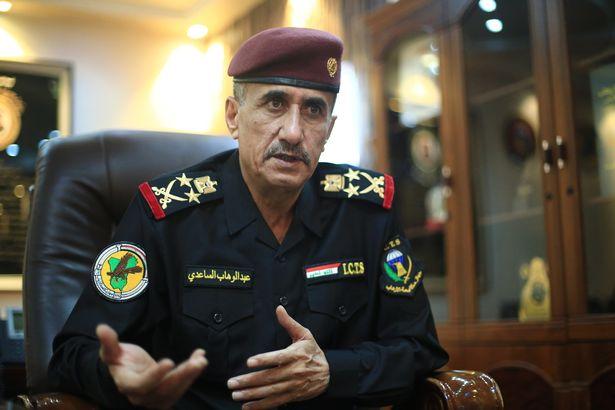
Islamic State leader ‘killed in airstrike’ as special forces bomb Iraq hideout
Iraqi special forces believe they have killed the head of Islamic State in an airstrike on a terror hideout.
Specialists are carrying out tests on DNA samples from the remains of a terror suspect collected after a cave was bombed in the Hamrin Mountains in north east Iraq.
It is believed Abu al-Hussein al-Husseini al-Qurayshi, who became leader in November last year may have been among five ISIS leaders blasted in the operation.
Elite commandos from the Iraqi “Golden Division” retrieved the dead bodies after warplanes hit the complex in an operation conducted recently.
Gen Abdul Wahab el-Saadi told the Daily Mirror: “Among these five men we know we killed a man who was heading the Islamic State’s media campaign.
“This man is never far away from the ISIS leadership so we believe and we hope that the Islamic State leadership has been killed.
“We cannot be sure yet but I believe DNA tests are currently being carried out. This may take some time.
“What we do know is that these five men were high up in Islamic State so we have had a positive result with that and many other operations.”
Al-Qurayshi, a veteran jihadist, took over as leader of the terror network in November last year after his predecessor Abu al-Hasan al-Hashmi al-Qurayshi was killed in Syria in October.
The latest and similarly named leader is a mystery man and it is believed there is little intelligence agencies know about his background.
He was at the time he took over, however, referred to by ISIS as “an old fighter” and commands huge respect amongst his terrorist subordinates.
British RAF planes recently carried out airstrikes on the Hamrin Mountains against Islamic State, flying in from RAF Akrotiri, in Cyprus.
But it is not known if UK Typhoon jets conducted this key mission on ISIS or whether it was conducted by an Iraqi fighter jet.
The ISIS leadership is becoming increasingly careful about security, rarely staying in one place for more than one night and spending most of their time in caves and desert hideouts.
And western spy planes are launching missions to pick up conversations over the internet and telephones in a bid to keep ISIS on the run.
It is known that whenever the terrorist network is allowed to stay in one place it may use its still large war chest to try and radicalise or instruct western-based jihadists to launch attacks.
What is ISIS?
Islamic State was born as an offshoot of al-Qaeda in Iraq, which had grown in the mid 2000s as a reaction to the US-led Iraq invasion.
It was headed by Jordanian Abu Musab al-Zarqawi, whose notoriety grew in Iraq from a number of sickening beheadings.
At some point, al-Qaeda in Iraq was disenfranchised by al-Qaeda. In 2006, al-Zarqawi was killed by American troops.
Disparate jihadist groups then came together to form ISIS – shortened from its full name, Islamic State in al-Sham, referring to large parts of the Middle East.
Sunni militant Abu Musab al-Baghdadi took over in 2010 and four years later led the network in a lightning-quick take-over of swathes of Syria and Iraq.
In 2014, al-Baghdadi announced his caliphate in Mosul, the group’s Iraqi HQ, after travelling from Raqqa, the ISIS Syria HQ.
Thousands of Iraqi police, soldiers and military cadets were slaughtered in their path and the group grew from strength to strength.
This was when British jihadists such as runaway ISIS bride Shamima Begum started travelling to Syria to join up.
The group slaughtered thousands of Yazidi and Shia across its territory and launched a campaign of horror across the region, expanding into Africa and Afghanistan.
A year later, it was plotting and carrying out attacks across Europe and coalition commanders started plotting a counter-offensive.
By 2019, air strikes and ground offensives by western-friendly Syrian Kurdish forces and Iraqi Army and Kurdish Peshmerga had removed the caliphate and fighters went to ground.
Al-Baghdadi was killed in a US special forces raid that year and the group has struggled since, with several more leaders killed.
But it remains a big threat in the Middle East, Afghanistan and parts of Africa.
ISIS attacks on UK
2010 MP Stephen Timms stabbed at a constituency surgery by British extremist Roshonara Choudhry. She is jailed for life.
2013 Soldier Lee Rigby is murdered in London by Michael Adebolajo and Michael Adebowale, who both get life sentences.
2017 Khalid Masood fatally stabs PC Keith Palmer after driving into pedestrians on Westminster Bridge, killing four and injuring almost 50.
2017 Suicide bomber Salman Abedi kills 22 and injures 139 – many of them children – at the Manchester Arena in the deadliest attack in Britain since the 7/7 bombings in 2005.
2017 Three ISIS murderers drive a van into pedestrians on London Bridge before stabbing people in nearby Borough Market. Eight killed and at least 48 wounded.
2017 Thirty hurt in a bombing at Parsons Green station in West London by Ahmed Hassan.
2018 Salih Khater runs down pedestrians outside the Palace of Westminster.
2019 Usman Khan is shot dead by police after killing two and injuring three more at London Bridge.
2020 Two inmates at Whitemoor prison wearing realistic fake suicide vests stab a prison officer, causing serious injuries and harming several others.
2020 Sudesh Amman shot dead by police after stabbing and injuring two people in Streatham.
2020 Khairi Saadallah stabs people in the centre of Reading, killing three and injuring three.
2021 David Amess MP knifed to death by Ali Harbi Ali in Southend, Essex.
Source » mirror





